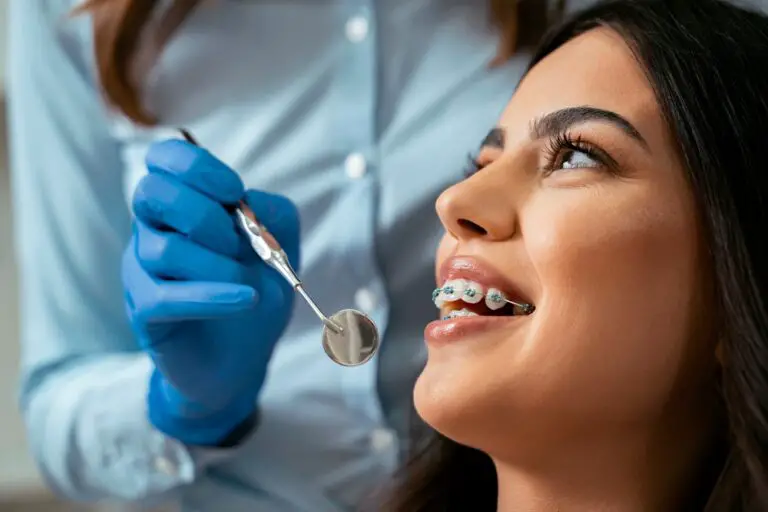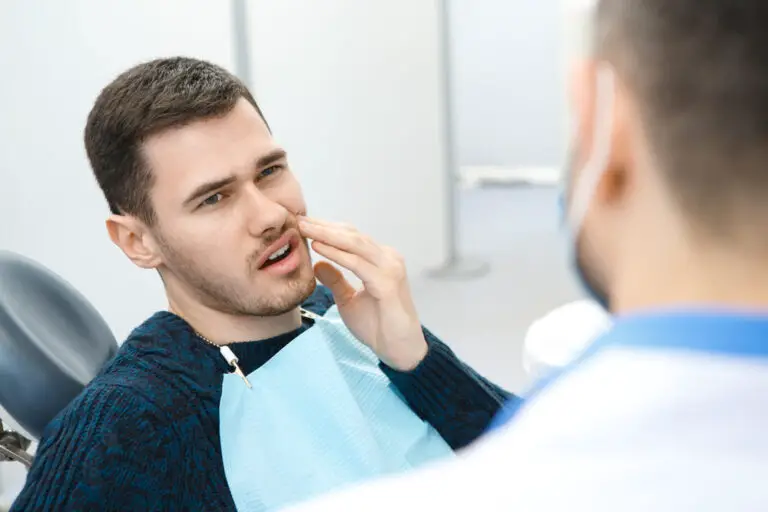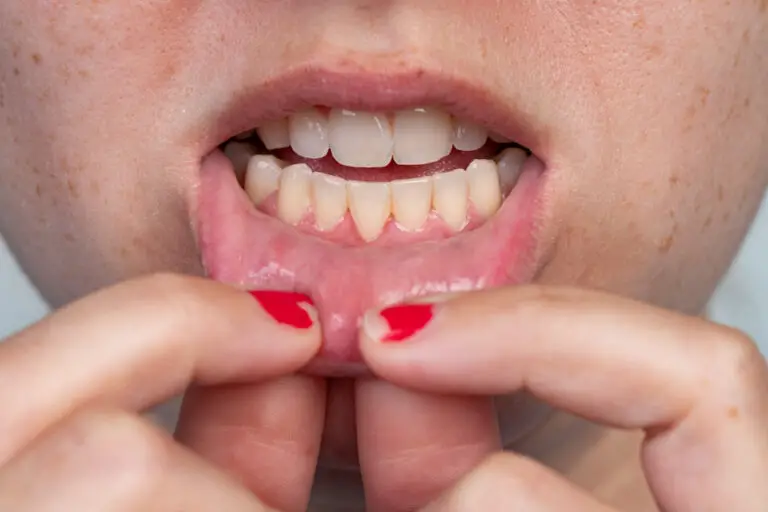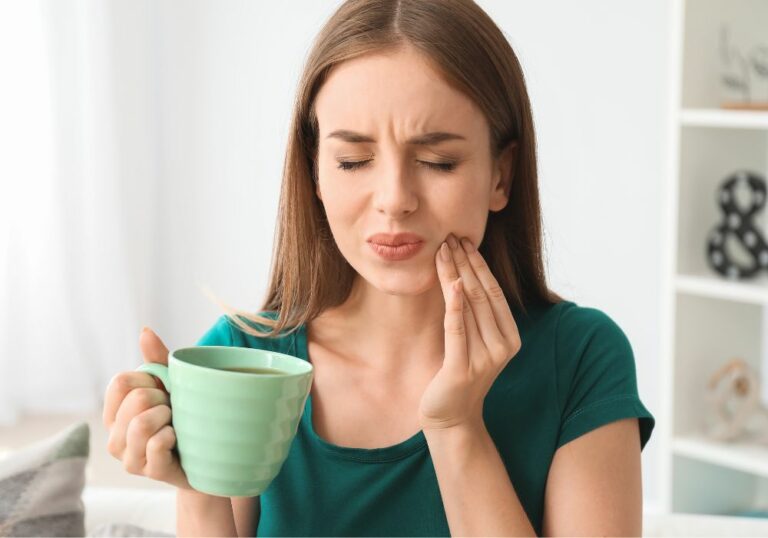What causes blackness on teeth?
Blackness on teeth, also known as black stains or extrinsic discoloration, has several potential causes:
Plaque buildup
Plaque is a sticky, colorless film of bacteria that constantly forms on teeth. When plaque isn’t properly removed by brushing and flossing daily, it can harden into tartar over time. Tartar is yellowish-brown and sticky. Both plaque and tartar provide a surface for stains to adhere to, making teeth appear darker and more yellow. The staining is often worse if you regularly consume chromogenic foods and drinks like coffee, tea, red wine, dark berries, tomato sauce and curry. These can deeply discolor plaque, leading to stubborn extrinsic stains on teeth.
Smoking
Smoking causes unsightly brownish-black stains on teeth due to the tar and nicotine in cigarettes adhering to dental plaque. The more frequently you smoke cigarettes, cigars, pipes or use other tobacco products, the worse and faster the discoloration becomes. Even occasional smoking leads to noticeable yellow-brown staining over time.
Certain medications
Some prescription medications like tetracycline antibiotics taken while permanent teeth are still developing in childhood can cause intrinsic grayish-brown discoloration of the dentin within teeth. However, other medications used long-term in adulthood like antihistamines for allergies, high blood pressure medications and antipsychotic drugs can also cause extrinsic surface stains. This is due to increased plaque buildup as a side effect.
Fluorosis
Consuming excessive fluoride while permanent teeth are developing, especially during the first 8 years of childhood, can result in a condition called fluorosis. This causes tiny white specks or streaks in teeth. These opaque areas develop brown stains over time that stand out against the brighter whiter areas of teeth. Fluorosis stains are more common in places with fluoridated drinking water and children who swallow toothpaste.
Trauma/Injury
A blow or injury to teeth, either from playing sports or a bad fall, can result in a gray, dark yellow or black discoloration of the affected teeth over time. The darkening occurs because trauma to teeth allows bacteria to enter the inner pulp chamber and dentin layers through cracks. The damaged pulp tissue eventually dies, and wastes released internally stain the dentin from inside.
Tooth grinding
Constant aggressive grinding or clenching of teeth wears away the outer protective enamel layer. This exposes the soft yellow dentin underneath, making teeth appear more transparent and darker, especially near the gum line and biting edges.
How can I get rid of blackness on my teeth?
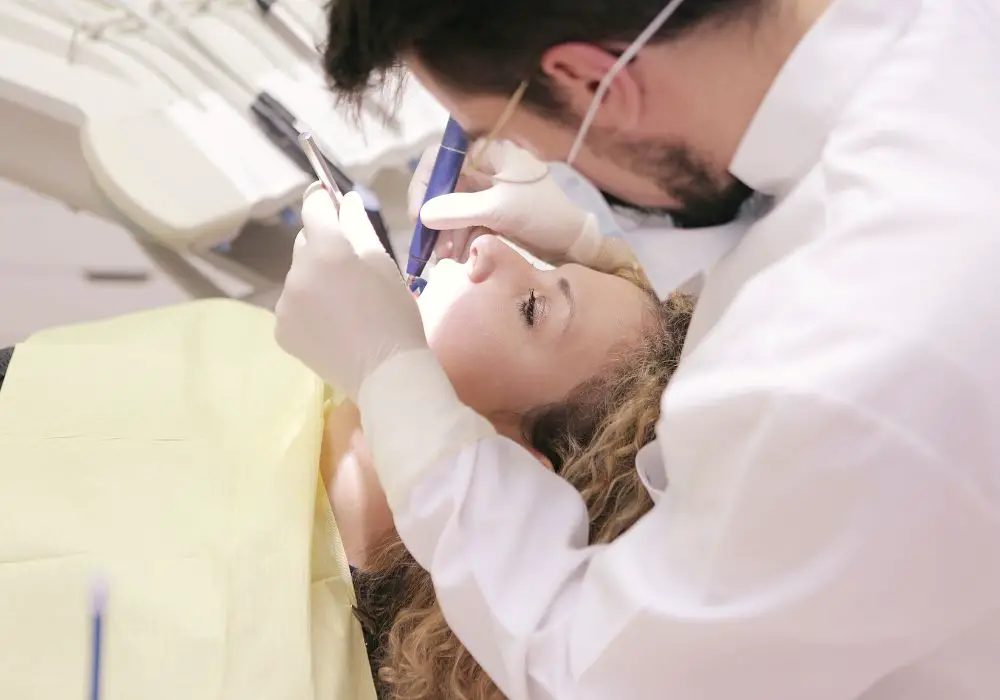
Here are the most effective professional and at-home methods for removing blackish or brown stains from teeth:
Professional dental cleaning
A routine dental cleaning by your dentist or dental hygienist every 6 months is important for removing stubborn accumulated extrinsic stains on the tooth surface caused by plaque, tarter and chromogenic foods/drinks. During a cleaning appointment, specialized tools like an ultrasonic scaler spray water to loosen debris and a high-powered suction tube is used to remove it. Hand scalers then scrape off stuck-on tartar above and below the gum line. Finally, polishing paste with a slightly abrasive texture is used with a rubber cup to buff away remaining surface stains on teeth.
Whitening toothpaste
Using an over-the-counter whitening toothpaste twice daily helps lightly scrub away extrinsic stains on teeth with gentle polishing agents. Look for toothpastes containing ingredients like silica, baking soda, hydrated silica or sodium hexametaphosphate listed for stain removal effects. Avoid highly abrasive toothpastes, which risk wearing away protective enamel over time with harsh scrubbing.
Bleaching strips or paint-on gels
Whitening products like disposable strips, dental trays with gel or brushed-on paint-on formulas use low concentrations of hydrogen or carbamide peroxide to safely bleach teeth. With daily or weekly application as directed, results are gradually seen within 1-2 weeks of consistent use as surface stains lighten. Home-use peroxide concentrations are typically 10% or less.
In-office power whitening
For more significant whitening with dramatic results seen immediately, your dentist can perform in-office power whitening. This involves using a stronger 15-35% hydrogen peroxide gel applied directly to teeth. The peroxide whitening agent is activated and accelerated using a special blue light or laser light shone on teeth for 30-60 minutes. Several visits may be required for tetracycline stains or to achieve maximum whitening.
Professional dental cleaning
A thorough teeth cleaning by a dental hygienist every 6 months removes accumulated plaque, tartar and extrinsic stains that daily at-home brushing and flossing can’t fully remove. The appointment involves careful scaling to remove hardened tartar as well as flossing and polishing with abrasive paste to smooth the tooth surfaces and brighten their appearance.
Avoid chromogenic foods/beverages
Minimizing consumption of foods, drinks and other products containing pigments that darkly stain teeth can prevent further discoloration. Examples to use sparingly include coffee, black tea, cola, red wine, dark berries, tomato sauce, soy sauce, tobacco, balsamic vinegar and curries. Drink them quickly at mealtimes instead of sipping slowly all day long. Rinse mouth afterwards.
Stop smoking
Quitting smoking and avoiding secondhand smoke improves dental and overall health, including stopping the accumulation of yellowish-brown nicotine stains on teeth caused by tar in cigarettes. Talk to your doctor about medications or nicotine replacements that can help you successfully give up smoking.
Use straws
When drinking staining beverages like coffee, tea, wine, soda, juice or sports drinks, use a straw to minimize contact with teeth. Allow the liquid to pass towards the back of the mouth over the tongue rather than swishing it around teeth. Also rinse your mouth with plain water after consuming to dilute residue.
Get dental work corrected
If old fillings, dental crowns, bridges, implants or other restorations don’t match the natural color of your teeth, these artificially whitened areas make your real teeth look darker and more yellow in comparison. Ask your dentist to replace any mismatched dental work with newer materials matched to your current whitened shade.
Whiten from inside
Some limited evidence indicates eating more raw fruits and vegetables with high vitamin C content could help remove mild stains over time from the inside by improving dental remineralization. Try making vitamin C rich healthy juices with lemon, apples, kiwis, broccoli, celery, carrots, pears or strawberries.
Laser teeth whitening
Laser teeth whitening performed by a dentist in-office can remove stubborn stains very effectively in a short period of time. A higher concentration hydrogen peroxide solution is first applied as a gel directly onto teeth. Next, laser light is targeted at teeth to accelerate and activate the bleaching agents. Results are seen immediately after the 30-60 minute session with up to eight shades of whitening.
Home Remedies to Remove Mild Blackness from Teeth

For mild discoloration, these natural home remedies may help remove surface stains gradually:
Baking soda and lemon juice
Make a thin paste by mixing a teaspoon of baking soda with a few drops of lemon juice. Gently yet thoroughly brush it onto teeth for 1-2 minutes, then rinse. Do not scrub aggressively, which could wear away protective enamel over time. Limit use to 1-2 times per week.
Hydrogen peroxide and baking soda
Mix a small amount of 3% hydrogen peroxide with baking soda into a paste. Carefully brush it onto discolored teeth for 1-2 minutes before rinsing. The peroxide acts as a mild bleaching agent to lighten stains. Use caution no more than 1-2 times weekly.
Coconut oil pulling
Swish a tablespoon of organic virgin coconut oil in your mouth for 10-20 minutes, forcing it through teeth before spitting it out. The fatty acids in coconut oil help pull out bacteria in the mouth and mildly whiten teeth over time with consistent daily use.
Apple cider vinegar
Dilute organic raw apple cider vinegar with water in 1:1 ratio. Gargle the mixture in mouth for 30-60 seconds before rinsing. Use no more than 1-2 times per week, as the acetic acid may erode enamel. Discontinue use if you experience tooth/gum sensitivity.
Strawberry whitening
Mash a few fresh ripe strawberries into a paste. Gently rub or brush the mixture onto stained teeth and let sit for 3-5 minutes before rinsing thoroughly with water. Strawberries contain malic acid, an organic compound with astringent properties that helps remove surface discoloration.
Activated charcoal
Mix a teaspoon of activated charcoal powder with water to form a thin, gritty paste. Use a soft brush to gently brush it onto discolored teeth for 1-2 minutes, then rinse. Avoid using vigorously, as charcoal is abrasive. Limit use to 1-2 times a week to avoid excessive enamel erosion.
Fruits and vegetables
Eating more fresh raw fruits and crunchy vegetables with high water content naturally helps scrub teeth clean daily. Apples, carrots, celery, broccoli, kiwis and strawberries increase saliva production while their crisp texture helps mechanically remove plaque and debris when chewed.
Avoid more stains
Reduce intake of dark staining foods and beverages. Drink them quickly with a straw if possible. Have them with meals rather than sipping all day. Rinse with water after. Also, stop tobacco use, as nicotine causes brown stains.
When to See a Dentist About Black Teeth
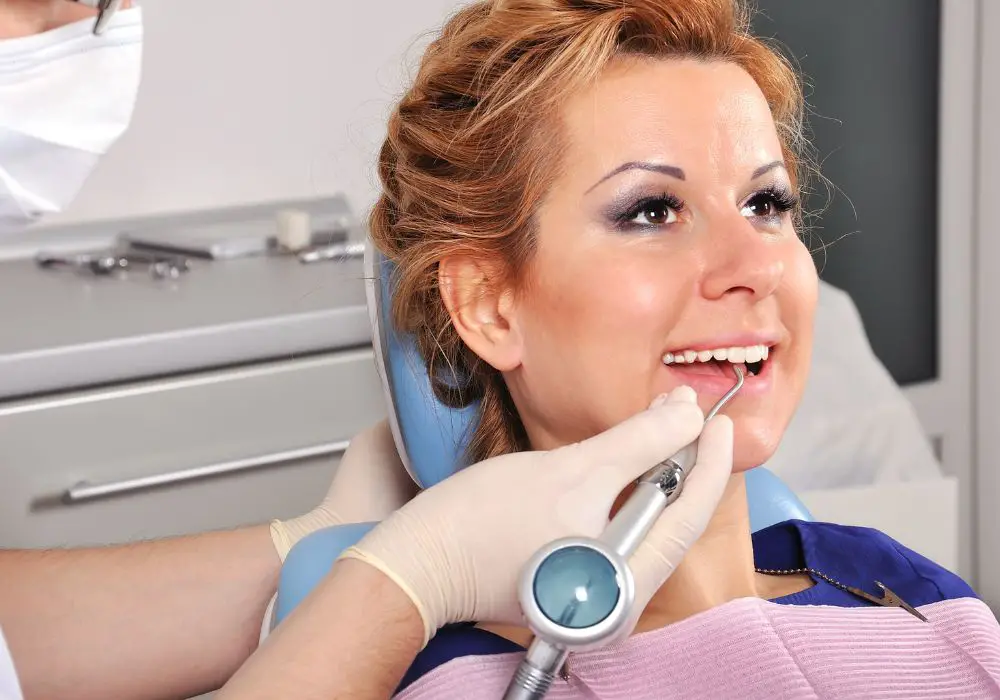
While home remedies can improve very mild discoloration, visit a dentist promptly if:
- Stains suddenly appear quickly, are uneven or only affect one tooth
- You experience any dental pain, sensitivity or other oral health issues
- Discoloration is result of injury, accident or trauma to teeth
- You smoke/drink staining beverages excessively
- Over-the-counter methods haven’t improved appearance after 2-4 weeks of consistent use
- You want to improve the color of old fillings, crowns or other restorations
- Teeth are darkened along the gum line and edges indicating gum disease
The dentist can determine the exact cause and severity of staining during an exam. They’ll be able to advise you on the safest, most effective professional teeth whitening treatments tailored for your needs. For very stubborn intrinsic stains or fluorescent cases, porcelain veneers or dental bonding may disguise the discoloration. Getting dental work promptly prevents worsening.
How to Prevent Blackness on Teeth
Prevention is key for maintaining a bright healthy smile and avoiding dental visits for discoloration treatment. Be proactive by:
- Brushing twice daily for 2 minutes with a soft fluoride toothpaste. Make sure to reach all surfaces.
- Flossing once daily gets between teeth to remove plaque brushing missed.
- Using mouthwash can help kill bacteria left behind after brushing. Pick one without alcohol.
- Getting professional teeth cleanings and oral exams every 6 months.
- Avoiding smoking, chewing tobacco and other sources of smoke/nicotine.
- Drinking dark staining beverages like coffee, tea and wine in moderation. Use a straw when possible.
- Rinsing mouth with plain water after consuming staining foods and drinks.
- Getting cavities, chips or damaged teeth repaired promptly before they worsen.
- Wearing mouthguards and helmets for contact sports to prevent dental trauma and injury.
- Taking all medications as directed, monitoring for oral side effects like dry mouth.
With diligent daily oral hygiene habits and regular dental visits, you can prevent unsightly blackish-brown stains from forming on teeth and keep your smile looking its brightest. Don’t neglect discoloration, as it tends to worsen over time without treatment. See your dentist quickly about any unusual spots.
FAQs About Blackness on Teeth
How long does it take for teeth to turn black?
Teeth darkening to black is a gradual process that occurs slowly over a long period of time, often years. The exact time frame depends on the specific cause and other factors like your oral hygiene habits. For example, heavy smokers may develop noticeable blackish-brown nicotine stains in a matter of months. Tetracycline staining usually develops gradually over several years after taking the antibiotics in childhood. Being proactive with brushing, dental cleanings and avoiding smoking can slow discoloration.
Can black teeth be whitened?
It depends on how deep or intrinsic the black stains are. Surface-level extrinsic stains from smoking, food/drinks, poor hygiene and plaque buildup often respond very well and can be reversed with professional and at-home whitening treatments. However, deeper intrinsic discoloration affecting inner tooth layers due to trauma, fluorosis, tetracycline exposure or root canal issues may be impossible to remove fully with just bleaching. Masking dark intrinsic stains may require other solutions like porcelain veneers or dental bonding.
What is the fastest way to whiten teeth?
In-office power whitening performed chairside by your dentist can dramatically whiten teeth by up to eight shades or more after just a single 30-60 minute treatment session. A concentrated 15-35% hydrogen peroxide gel is applied directly to teeth before a special light or laser is used to accelerate and activate the bleaching agents. Over-the-counter whitening strips used daily as directed for 1-2 weeks can also lighten teeth up to four shades if used consistently. Avoid “instant” whitening products claiming drastic whitening immediately, as these typically contain abrasives that damage enamel.
Can charcoal really whiten teeth?
Activated charcoal toothpaste and powders have recently gained popularity for whitening teeth. Proponents claim the super fine black charcoal powder works like a magnet to absorb and draw out surface stains from teeth. However, there’s currently limited scientific evidence showing charcoal is an effective teeth whitener compared to other methods. Some dentists actually warn the gritty charcoal is too abrasive for long-term use and may slowly damage tooth enamel and gum tissue when scrubbed vigorously against teeth. More research is needed.
Does oil pulling actually whiten teeth?
Oil pulling is an ancient Ayurvedic oral health practice that involves swishing oil around the mouth for up to 20 minutes to pull out bacteria and toxins before spitting it out. There’s limited evidence showing coconut oil has antimicrobial and anti-plaque benefits when used daily. This may gradually reduce stains on teeth over several weeks. However, oil pulling alone doesn’t produce dramatic whitening. More studies are needed to confirm effects on teeth stain removal. It cannot completely replace brushing and flossing.


